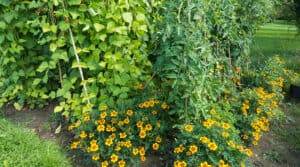Rainwater harvesting from your roof is a great way to collect water on your property. Alongside other permaculture water management strategies, it can be a key step in making sure that you are living and gardening in a sustainable, eco-friendly and ethical way.
Why Harvest Rainwater From Your Roof?
In my article on permaculture perspectives on water management, I discuss in depth the importance of managing freshwater wisely on our properties, before exploring some of the many ideas permaculture practitioners might use when doing so.
In that article, I discuss a number of the broader concepts relating to water use and water management on land. In this one, we are taking a much narrower focus, and looking at rainwater harvesting and collection at a domestic scale – in the typical home garden.
While at least some of the ideas discussed in this previous article could be useful as you work out how best to manage water on your property, it can be helpful to take things back to basics and focus on how we can all harvest rainwater from the roofs of our homes.
While it is also important to catch and store rainwater within the wider landscape, focussing on a single rooftop can be a great place to start. For reasons of sustainability, cost and plant health in a garden, harvesting rainwater from your roof is an excellent idea.
Rainwater Harvesting is a Sustainable Choice
Many of us have become used to water on tap. But few actually take the time to think about where their water actually comes from and what water systems in the area might cost.
In many regions, water is in short supply, and reliance on mains systems can deplete already limited water resources for a community, and bring costs in terms of energy use and environments.
But even where water is not in short supply, harvesting rainwater and using this instead of mains water for your garden, or even your household needs, can be the sustainable and eco-friendly choice.
By harvesting rainwater on our own properties, from our own rooftops, we can become far more resilient and self-reliant – and can withdraw our support for potentially damaging external systems.
Another thing to consider is that catching and storing water runoff from roofs (as well as driveways, paving etc. on your property) can prevent pollution of nearby waterways, the sea or ocean.
Rainwater Harvesting Saves Money
If you are on a metered water supply, of course you can also save money on household bills by obtaining water for free when it rains.
But even if you don’t pay for water in this way, rainwater harvesting can still be a great investment. Systems don’t cost a fortune to implement, and you can potentially reap dividends in the form of healthy, well-watered crops from your garden.
Being focussed on the long-term health of your garden, and building resilience and self-reliance can allow you to obtain a wide range of yields, and potentially also to save money by avoiding common pitfalls as you maintain the systems in your home and garden.
Rainwater Can Be Better for Plants Than Municipal Water Supply
Rainwater can also be more beneficial for the health of the plants you grow than many municipal water sources.
City water can contain chlorine and other chemicals that can sometimes affect the growth of certain plants. Rainwater may also have a more balanced pH than some tap water, so won’t affect plants by changing the pH of your soil or growing medium.
Harvesting Rainwater from the Roof of Your Home
The place that most people will begin is with harvesting rainwater from the roof of their home. In many cases, if you have a detached home, this is very simple and straightforward.
In certain cases, however, if you live in an apartment for example, more ingenuity and clever design may be required. But even in a city block where there are restrictions on what is possible, there will often still be ways to co-operate with neighbours and harvest rainwater in some way from or on the roof of the building in which you live.
Harvesting Rainwater From Other Garden Structures
If you have a garden, another thing to consider is that you can harvest rainwater not only from the roof of your home but also from any other garden structures such as garages, summerhouses, sheds, or even greenhouses or hoop houses/ polytunnels.
Any roofed structure to which guttering can be added can allow for more rainwater collection. You just need to get inventive and develop ways to attach guttering to the structure.
How To Create a Rain Barrel System
The process of creating a rain barrel system is very simple and straightforward. It need not cost the Earth, and should be one of the very first steps for those who want to grow their own at home.
Before you even start to create growing areas, you should make sure that you have the basics of rainwater harvesting and composting systems in place. This will help you make sure that the garden you create really can stand the test of time.
To create a rain barrel system:
1. Determine Rainfall in Your Area
Knowing how much rain falls in your area over the course of each year, and the precipitation patterns where you live is crucial to managing that water wisely.
By combining that rainfall figure with the area of the roof in question, you can work our how much water you will collect, and, if you are directing that water into a rain barrel or another collection vessel of some kind, how large it will need to be to collect all of the water from the roof.
2. Choose a Collection Vessel (or Determine Where Rainwater Should Be Directed)
The simplest and most straightforward option when harvesting rainwater from a roof might be to choose a vessel or vessels that can hold all the water that falls over the course of a year.
However, depending on the rainfall in your area, and the size of your roof, collecting and storing all of the water in this way might not be practical.
Of course, you might also calculate how much water will be used from a rainwater barrel and determine that capacity is sufficient as water will be used before the vessel is refilled.
But another option is to direct the water not to a storage vessel but to another location. (We’ll explore some ideas a little later in this article.)
If you are using a rainwater barrel, butt or other container to collect rainwater from your roof, then you will need to think about what you will use. There are a number of options that you can purchase, but you might also consider using reclaimed materials or items for the project.
For example, you might use old 55 gallon barrels or drums, an old wooden barrel, or an old water tank from a home that might otherwise have been discarded during a renovation project.
It can be useful to have a tap/faucet at the base of any collection vessel that you choose, so that the water can easily be used, or directed onwards from this point.
3. Install Guttering if it is Not Already Present
Homes in higher rainfall areas will typically already have guttering that collects the rain that falls on rooftops and directs it downwards – either into municipal drainage systems, or to empty out at ground level.
If there is not already guttering installed on your home, then of course you will need to install some, with a downspout (or typically more than one) that bring(s) water from the gutters down into your collection vessel or vessels.
Installing guttering can be more expensive than simply adding a rainwater barrel to an existing guttering system. But you can keep costs down, again, by using reclaimed materials, and taking a DIY approach. Metal, plastic and even bamboo guttering might all, depending on where you live, be options to consider.
4. Decide Where to Place a Rain Barrel or Water Collection Vessel
The shape of your home and the position of existing downpipes on your home might dictate the placement of rain barrels. But you might also consider best placement for a rain collection vessel within the context of an overall design for your garden.
Placement can depend on how you plan to use the rainwater that you collect – something that we will explore below.
It will also depend on the placement of other elements within a design around your home, and on where a vessel can practically be placed.
Another interesting thing that you might consider is how is could be beneficial to place a rainwater collection vessel within a greenhouse or another undercover growing area, where it can soak up the sun’s heat during the day and where its thermal mass can help regulate temperatures within the space – keeping things warmer in winter and cooler in summer.
5. Connect Guttering to Your Rain Barrel or Water Collection Vessel
As well as the guttering around the edges of the roof, you will also need to think about down pipes (or rain chains in lower rainfall areas) to direct the water downwards to your rain barrel.
The final step is to cut into an existing downpipe, or create this downwards connection, to make sure that the water from your roof ends up within the water barrel or other collection vessel.
Determine Where Water Will Go Next
Thinking about where the water will go from the rainwater harvesting barrel or other collection container is another important part of the picture. It is important to consider this as you develop your design and create the rainwater harvesting system.
You might simply drain off water from your rain barrel into a watering can and use it to water by hand in your garden.
However, you might also direct water from the barrel to where it is needed through a gravity-fed drip irrigation system, for example, or to a specific area in your garden.
You can also direct water into aquaponics systems, or other water-based growing systems. Or to a garden pond.
This is where it really comes in handy if you have spent some time thinking not only about the water collection itself, but about how this might integrate with the rest of a garden design.
On my own property, where we have a large roof area and fairly high rainfall, we have several rainwater barrels that connect through underground pipes to a tap outside my polytunnel, to which an irrigation system can be connected.
We also have some barrels that provide water for hand-watering, from the tap at the base, and some places where water is directed straight, without storage, to other parts of the property.
It is also possible to think about passing rainwater through a filtration system so that it can be utilised for drinking water, sanitation etc. within your home.
Rainwater Filtration
In certain areas, and when rainwater is to be used for certain uses, it can be a good idea to think about diverting it through a filtration system. Simple filters of straw/ charcoal, sand and gravel can remove particulates prior to use. Reed beds or other phytoremediation areas can use plants and micro-organisms to filter further impurities out of the water before it is used.
Should you wish to do so, it is also possible to use more sophisticated modern filtration systems to turn rainwater into a water that will be suitable for use inside your home. This can be a useful option to consider in off-grid situations.
Alternatives to Storing Rainwater in a Rain Barrel
As mentioned above, using barrels of other vessels to collect rainwater from your roof is only one option. You might also harvest rainwater from the roof allowing it to flow from downspouts directly to places where the water can infiltrate, be stored or used within the garden.
Rain Gardens & Other Water Management Garden Features
For example, you can direct the rainwater from your roof through swales or drainage channels to a rain garden or other water management feature that allows that water to seep slowly into the soil, being slowly filtered by plants and soil rather than just flowing directly off your property.
Ponds or Reservoirs
You might also, if rainfall is higher and barrels not practical, direct water from your roof into a pond or another standing body of water on your property. Creating a wildlife pond can frequently be a great idea, even in a smaller garden.
Irrigation Systems
There may also be potential to filter and direct rainwater for use in irrigation systems elsewhere on your property, whether through swales or irrigation channels, or through pipes to specific spots.
There are a great many interesting options to consider when it comes to directing rainwater into areas of food production or other garden growing areas, even if you do not choose to first contain the water collected from your roof in a rain barrel or other container.
However you choose to catch, store and direct water on your property, thinking about the water that falls on your roof is a great place to start.







